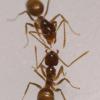I have decided to compile a list of things that you use to treat a bit or sting by certain types of ants like Pogonomyrmex and Solenopis. Here is what I do after raiding a Solenopis mound for pupae, or anting a Formica nest.
Cures
0. Assess whether or not you are allergic to ant stings. You should really do this beforehand, as assessing this is critical. If you are allergic, don't go anting for ants that bite and sting.
1. Pluck the ants manually off the skin. Never brush them off, because they will hang on with their mandibles and will get agitated. Never slap or shake them either.
2. Wash the wound are with soap and water to remove any debris.
3. Take rubbing alcohol and rub it on the skin to suppress the itching and histamine levels. It also kills microbes.
4. Rub ice on top. The swelling stops and pain seems to slow.
What do you use for ant bites and stings from ants? Any other home remedies?
Edited by William. T, August 22 2015 - 10:10 AM.


















